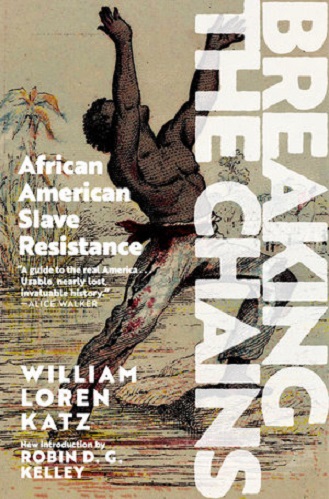Breaking the Chains: African American Slave Resistance

Generations of American history students have grown up believing that enslaved people accepted their lot and became attached to their enslavers, that rebellion was rare and that liberation from slavery happened thanks to the enslavers.
In this newly updated version of a celebrated history book first published in 1990, high school teacher and children’s book author William Loren Katz offers a closer look at the lives of enslaved people in the United States, from their African abductions through to their brave resistance to harsh plantation life and their roles in the Civil War. It documents how enslaved people themselves were a driving force behind their emancipation.
With an introduction by historian Robin D. G. Kelley, new black and white illustrations and photographs, and updates from the original version throughout, this new release is an eye-opener to anyone who values history.
This updated version of a young-adult history book is an astounding, powerful and wonderfully readable treasure-trove of material, all meticulously retrieved from an era in which escaped slaves were debriefed by people set on collecting their stories in the former slaves’ own words. Be these long-ago recorders literate Blacks or whites, abolitionists or reporters, they left records that allowed a phenomenally dedicated researcher and teacher, William Loren Katz, to dig deep (for three decades) for a perspective rarely heard. In other words, unlike many histories of the slave trade and emancipation, this one is told by people of that era, especially slaves and former slaves. I highly recommend this edition, with its new introduction, illustrations, photos and updates.
I do vigorously disagree that it’s for “ages 10 and up.” I would have no one under 12 read a book that mentions rape several times.
That being said, I consider it one of the most impressive history books I’ve read; I was constantly astounded by information I’d never heard before, and glued to the old illustrations and photographs. I could not put it down, and it’s a history book, not my usual genre. The best stories are about slaves heroically outwitting their enslavers by methods ranging from feigning sickness to hiding in swamps, to committing arson or poisoning those who hurt them. Like the two Black railroad workers who, upon seeing an oncoming, roaring locomotive, jumped off their handcar without telling the overseer riding with them. Many other more sobering accounts involve what slaves were willing to sacrifice in order to protect or reunite with loved ones, to rebel or escape.
Here’s just a taste of what I learned:
In 1562, Captain John Hawkins launched the English trade in enslaved people with a few small ships, 100 crewmen and 300 captured African men, women and children. Queen Elizabeth first denounced his effort and said it was “detestable and would call down vengeance from heaven.” But after she saw Hawkins’s huge profit, she became a major shareholder in his next African expedition.
In the Georgia Sea Islands, shoes were handed out once a year to slaves, a blanket every three years. Boys and girls younger than thirteen were not given clothing.
A Black child received her worst whipping for playing with a doll that belonged to her enslaver’s family. A hungry child was beaten for eating a biscuit.
Whites used to spell out words so Blacks couldn’t understand what was going on, recalled one female slave, “but I ran to Uncle and spelled them over to him, and he told me what they meant.”
In Natchez, Louisiana, Milla Granson, who learned to read from the children of her Kentucky master, ran a “midnight school” of 12 pupils each term that taught reading and writing between 11 p.m. and 2 a.m. She graduated hundreds.
One planter found that a man he considered too blind to work in the field made “18 good crops for himself when the [Civil] War was over.”
A man named Jake told his Virginia enslaver, “You can sell me, lash me, or kill me. I ain’t caring which, but you can’t make me work no more.” The owner thought for a moment and said, “All right, Jake. I’m retiring you, but for God’s sake don’t say anything to the other niggers.”
It became so common for slaves to light their enslavers’ property on fire that in 1820, the American Fire Insurance Company of Philadelphia announced it “declined making insurances in any of the slave states.”
In the South during the Civil War, slaves often snuck into jails to feed or free Union soldiers.
Six men escaped from Key West, Florida, in 1858 in a small boat and sailed to the Bahamas. They decided to write their enslavers. Most wrote insulting letters, a few apologized for taking his good horse, and one signed his letter “Your most obedient servant.” Sometimes formerly enslaved people sent enslavers bills for their labor.
At the Magruder plantation, enslaved workers rode into the yard on horseback, baked biscuits in the main house, took a bundle of bread and went back home to bed.
As the South lost laborers (slaves escaping), the Union army gained willing volunteers. Over campfires, after battle, young white soldiers taught Black refugees the magic of reading and writing. And as the Union Army advanced South, “the great majority of negroes – 80 percent – remained behind and came into our line.”
One of the most unusual wartime escapes was planned by Robert Smalls, the enslaved pilot of the Confederate battleship Planter, and his Black crew. On the evening of May 13, 1862, after the white captain and officers left the ship, Smalls and his African American crew picked up their families and loved ones on the shore. Smalls blinked the correct signal at Confederate-held Fort Sumter, sailed out of Charleston harbor at 4 a.m. and surrendered to the Union Navy.
During the Civil War, most Northerners were as strongly infected as enslavers with a belief in Black inferiority and bitterly resented fighting for Black liberation. Northern whites feared newly freed enslaved people would settle in the North and by working for less pay, take their jobs. This fear of emancipation and an unpopular military draft led to city rioting by the poor and uneducated.
QUOTES
In 1809, a South Carolina court ruled that “young slaves… stand on the same footing as other animals.”
[Slaves are] “a very troublesome species of property.” – President George Washington, 1794
Not all was straightforward. During the Civil War, as enslaved people deserted the plantation, one South Carolina planter realized his slaves’ true feelings. “We are all laboring under a delusion. I believed that these people were content, happy and attached to their masters. But events and recollection have caused me to change these opinions.”
Emily Douglass of Natchez always boasted of the undying loyalty of those she enslaved, but during the Civil War, “They left without even a good-bye.”
Formerly enslaved man Arnold Cragston spent four years rowing hundreds from Kentucky across the Ohio River, saying, “We just knew there was a lot of slaves always a-wantin’ to get free, and I had to help ’em.”
Without his Black troops, President Lincoln wrote in August 1864, “we would be compelled to abandon the war in three weeks.”
When her servants suddenly disappeared, one woman enslaver asked, “If they’re not my slaves anymore, then whose are they?”
President Abraham Lincoln, though he personally hated bondage, initially stated his aim was to save the Union and not interfere with the South’s “internal institutions.” He reassured all Americans, “If I could save the union without freeing any slave, I would do it.”
-Pam Withers

